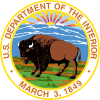- Oscar L. Chapman
-
Oscar Littleton Chapman (October 22, 1896–February 8, 1978) was the United States Secretary of the Interior during the last three years of the Truman administration.
Chapman was born in Omega, Virginia. He attended the University of Denver, where he earned his LL.D. at Westminster Law School, and the University of New Mexico.
From 1918 to 1920, Chapman served in the United States Navy Medical Corps.
Chapman was the manager of Edward P. Costigan's U.S. Senate campaign in 1930, and the Alva B. Adams Senate campaign in 1932. After Roosevelt's election in 1932, he was appointed as an Assistant Secretary in the Department of the Interior.
In 1939, Chapman was an early victim of the House Committee on Un-American Activities, as then-chairman Martin Dies Jr. published a list of government employees who were members of a Communist-controlled organization (Chapman was considered a member because there was a record that he had contributed two dollars to the American League for Peace and Democracy which was raising money for the loyalists during the Spanish Civil War).
At the 1944 Democratic National Convention in Chicago, Chapman impressed Truman by sticking to his early agreement to support the current vice-president Henry A. Wallace. He was promoted to under secretary by Harry S. Truman in 1946. Chapman was one of Truman's advisers supporting the decision to recognize the state of Israel in May 1948, over the objections of the State Department.
Chapman worked to promote Truman in the 1948 election, and in late 1949 was promoted again to Secretary of the Interior, replacing Julius A. Krug who had not supported Truman's campaign.
In 1951, Chapman denied a government loan to an aluminum company being run by Lea M. Harvey because of a scandal that Harvey had sold artillery shells to the Navy during World War II that were dangerously out of specification.
After the end of the Truman administration in 1953, Chapman practiced law in the firm of Chapman, Duff and Paul.
Political offices Preceded by
Julius A. KrugUnited States Secretary of the Interior
Served under: Harry S. Truman
1950–1953Succeeded by
Douglas McKayUnited States Secretaries of the Interior Ewing • McKennan • Stuart • McClelland • Thompson • C Smith • Usher • Harlan • Browning • Cox • Delano • Chandler • Schurz • Kirkwood • Teller • Lamar • Vilas • Noble • M Smith • Francis • Bliss • Hitchcock • Garfield • Ballinger • Fisher • Lane • Payne • Fall • Work • West • Wilbur • Ickes • Krug • Chapman • McKay • Seaton • Udall • Hickel • Morton • Hathaway • Kleppe • Andrus • Watt • Clark • Hodel • Lujan • Babbitt • Norton • Kempthorne • Salazar
Cabinet of President Harry S. Truman (1945–1953) Vice President None (1945–1949) • Alben W. Barkley (1949–1953)
Secretary of State Edward Stettinius, Jr. (1945) • James F. Byrnes (1945–1947) • George Marshall (1947–1949) • Dean Acheson (1949–1953)Secretary of War Secretary of Defense James Forrestal (1947–1949) • Louis Arthur Johnson (1949–1950) • George Marshall (1950–1951) • Robert A. Lovett (1951–1953)Secretary of the Treasury Attorney General Francis Biddle (1945) • Tom C. Clark (1945–1949) • J. Howard McGrath (1949–1952) • James P. McGranery (1952–1953)Postmaster General Secretary of the Navy James Forrestal (1945–1947)Secretary of the Interior Harold L. Ickes (1945–1946) • Julius A. Krug (1946–1949) • Oscar L. Chapman (1949–1953)Secretary of the Agriculture Secretary of Commerce Henry A. Wallace (1945–1946) • William Averell Harriman (1946–1948) • Charles W. Sawyer (1948–1953)Secretary of Labor Categories:- Truman Administration cabinet members
- 1896 births
- 1978 deaths
- United States Secretaries of the Interior
Wikimedia Foundation. 2010.

